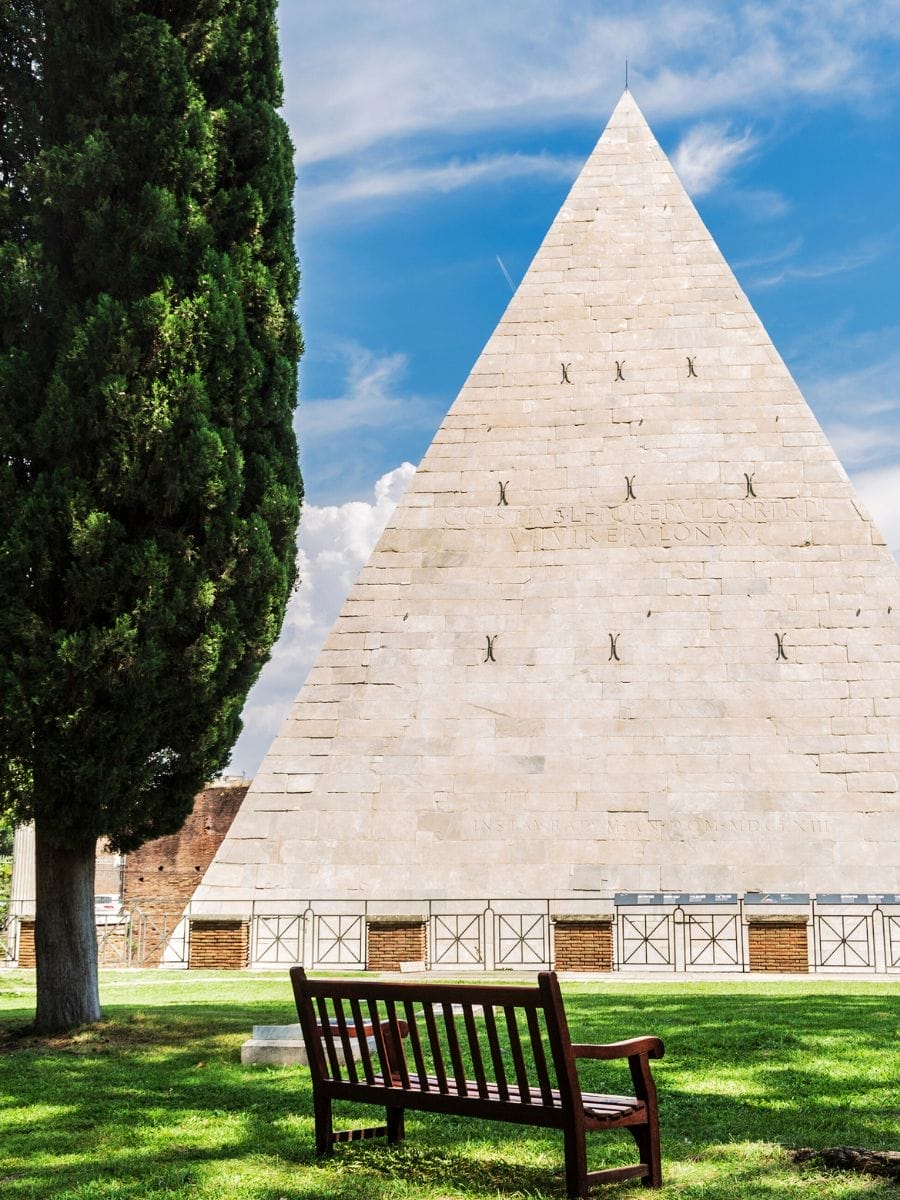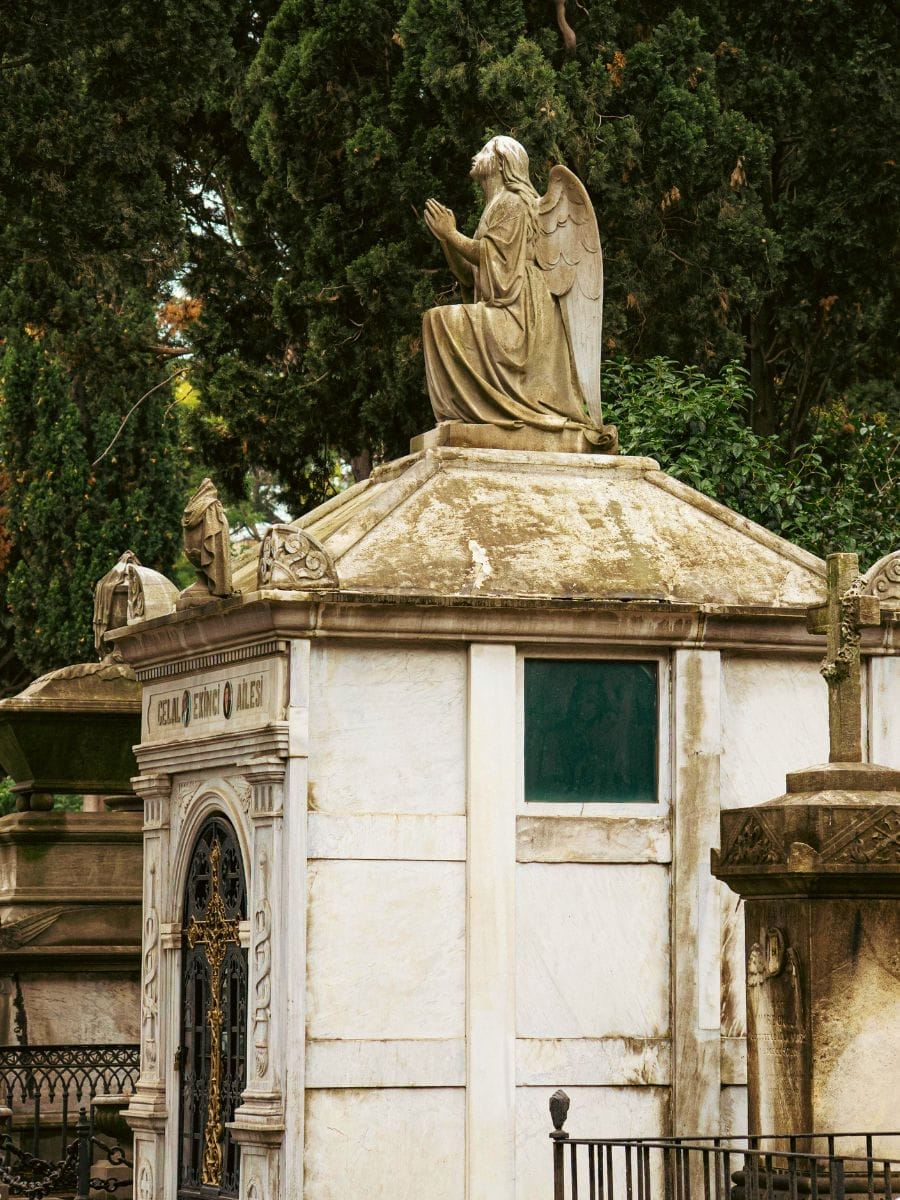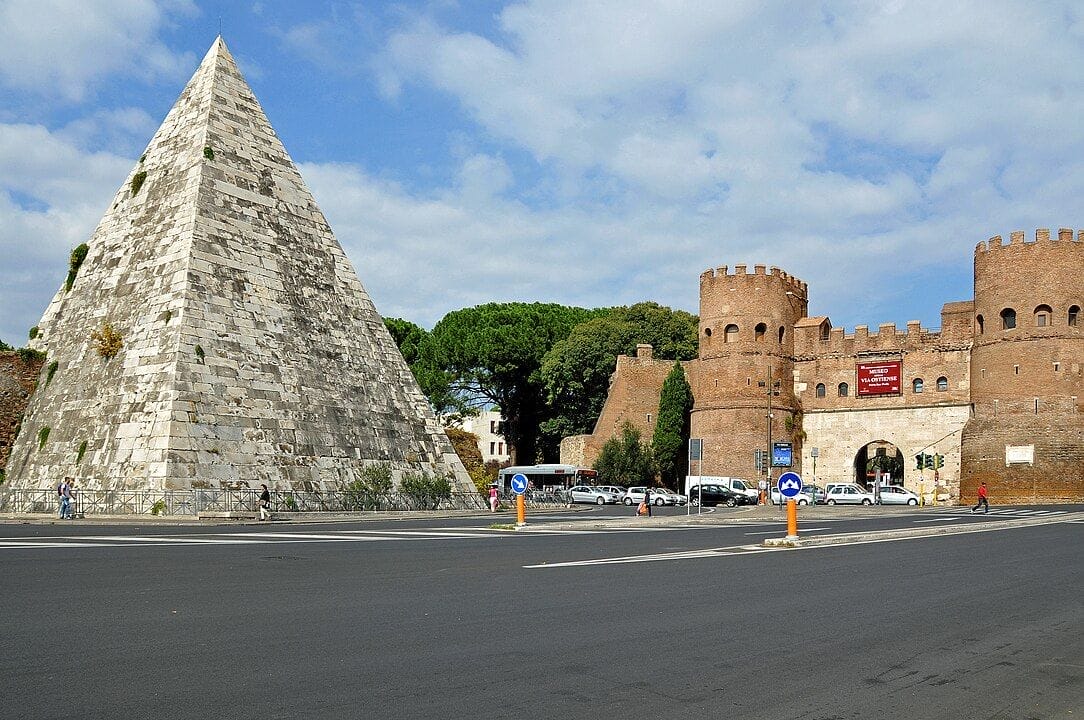
The Pyramid of Cestius in Rome: History, How to Get There & Tips for Your Visit
There are monuments you expect to see in Rome : the Colosseum, the Trevi Fountain, the Pantheon… But an Egyptian pyramid in the heart of the Italian capital? That’s definitely unexpected! And yet, it’s real: the Pyramid of Cestius, or Piramide di Caio Cestio in Italian, is one of Rome’s most unusual and least-visited landmarks.
Located in the Ostiense district, right next to Porta San Paolo and the Piramide metro station, this striking white monument made of Carrara marble has stood proudly for over 2,000 years.
Its elegant shape and unique setting, nestled between the Aurelian Walls and the Non-Catholic Cemetery, make it well worth a visit. The area around the Pyramid of Cestius in Rome also offers a quieter, more authentic glimpse of the city, far from the usual tourist crowds.
In this guide, you’ll find everything you need to plan your visit to the Pyramid of Cestius:
- how to get there easily,
- opening hours and ticket information,
- the history behind this fascinating monument,
- and the best nearby places to visit to complete your walk.
Ready to discover one of Rome’s most unexpected treasures? Let’s go!
Contents
What is the Pyramid of Cestius?
You’re wandering through the south of Rome, looking around at the bustle of the city, when suddenly… a white pyramid appears between the cars, scooters, and metro tracks. Yes, you’re seeing right, there’s an Egyptian-style pyramid right in the heart of Rome! It’s the Pyramid of Cestius, or Piramide di Caio Cestio in Italian, one of the most surprising and fascinating monuments in the city.
Located in the Ostiense district, just a short walk from Porta San Paolo and the Piramide metro station, this striking landmark instantly catches the eye of any curious traveler. You wouldn’t expect to find such a monument in Italy, and yet, it has stood here for more than 2,000 years.
Standing 36 meters high and almost 30 meters wide at the base, the Pyramid of Cestius in Rome holds its own against its Egyptian counterparts. Clad in gleaming white Carrara marble, it shines brilliantly under the Roman sun, standing out beautifully against the city’s blue skies.
People often say it’s “sharper” than the pyramids of Egypt, and it’s true. Its steep angle gives it a slender, almost futuristic look. Roman architects took inspiration from Egypt after its conquest in 30 BC, when Egyptian art and architecture became highly fashionable in Rome.
You can admire this remarkable monument from Via Raffaele Persichetti or Piazza di Porta San Paolo, both great spots for photography. If you’re hunting for unique photos of Rome, different from the usual Colosseum or Pantheon shots, the Pyramid of Caius Cestius offers a truly distinctive backdrop, with the Aurelian Walls and ancient ruins framing the scene perfectly.

Practical Information for Visiting the Pyramid of Cestius
Planning to visit the Pyramid of Cestius in Rome? Good news, it’s one of the easiest monuments to reach and completely free to admire. Here’s everything you need to know to plan your visit without any stress.
Where is the Pyramid of Cestius Located in Rome?
The Pyramid of Cestius stands in the Ostiense district, just south of Rome’s historic center, right on the edge of the Testaccio neighborhood.
- Address: Via Raffaele Persichetti, 00153 Roma RM, Italy
It’s located directly across from Porta San Paolo, a monumental ancient gate that was once part of the Aurelian Walls.
The site is hard to miss, the pyramid rises dramatically in the middle of a busy intersection served by the metro, tram, and several bus lines. If you’re arriving via the Piramide metro station (Line B), you’ll see it the moment you step outside.
How to Get to the Pyramid of Cestius in Rome
There are several easy ways to reach the Pyramid of Cestius:
- By metro: Take Line B and get off at Piramide station. As soon as you exit, the pyramid will be right in front of you.
- By bus: Lines 23, 75, 280, or 716, get off at Porta San Paolo. All of them stop just steps away from the monument.
- By tram: Lines 3 and 8, stop Porta San Paolo. This is a convenient option if you’re coming from Trastevere or the Colosseum area.
- On foot: If you’re already exploring southern Rome, you can easily walk from Testaccio (about 10 minutes) or Trastevere (around 25 minutes). The walk is pleasant and gives you a glimpse of a more local, everyday Rome
Travel Tip : Avoid driving here. The area is often congested and part of Rome’s ZTL (limited traffic zone). Public transport or walking are your best options, especially if you plan to explore the Ostiense neighborhood afterward, known for its street art and authentic Roman atmosphere.
Can You Go Inside the Pyramid of Caius Cestius?
That’s usually the first question travelers ask, can you go inside the Pyramid of Cestius?
Well… not really.
The interior of the Pyramid of Caius Cestius is closed to the public most of the year, as it’s a fragile archaeological site. You can, however, admire it freely from the outside, in the small park that surrounds it.
Occasionally, the pyramid opens for special guided tours, usually on the 3rd and 4th weekends of the month, on Saturday and Sunday mornings. These visits are rare and must be booked in advance, so if you’d like to try your luck, check the official website of the Archaeological Superintendency of Rome or call +39 06 399 67 700 for updated schedules.
Tickets and Admission
Good news, visiting the Pyramid of Cestius is completely free!
You can walk up close and admire it at any time without a ticket or reservation.
Right next to it, you’ll find the Non-Catholic Cemetery of Rome (Cimitero Acattolico), another peaceful and beautiful spot worth visiting. Entry there is also free, but it’s customary to leave a small donation (a few euros) to help maintain the site.
Opening Hours
The Pyramid of Cestius itself doesn’t have fixed opening hours since it can only be viewed from the outside. You can stop by at any time of day to admire it.
Tips for Visiting the Pyramid of Cestius
- Plan to spend about 10 minutes admiring the pyramid itself, or around 40 minutes if you also visit the Non-Catholic Cemetery next door.
- Visit in the morning or late afternoon, when the sunlight highlights the white Carrara marble and creates a beautiful glow on the monument.
- For the best photos of the Pyramid of Cestius, head to the Porta San Paolo side, the contrast between the bright stone and the surrounding ancient walls makes for stunning shots.
- And if you’re in the area in the evening, come back after sunset. The Pyramid of Cestius at night is beautifully illuminated, and the view is absolutely worth it.
History of the Pyramid of Caius Cestius
Who Was Caius Cestius?
Behind this unusual monument lies a somewhat mysterious name: Caius Cestius Epulo.
He was an influential Roman magistrate of the 1st century BC and a member of the prestigious college of the Septemviri Epulonum, the priests responsible for organizing sacred banquets in honor of the gods.
Nothing particularly “pharaonic” about that, but at the time, Romans were fascinated by Egyptian culture. After the conquest of Egypt by Emperor Augustus in 30 BC, Egyptian art and architecture became incredibly fashionable in Rome, obelisks, frescoes, and even pyramids were all the rage.
Caius Cestius decided to follow this trend by asking for his tomb to be built in the shape of an Egyptian pyramid. It was a bold choice, showing both his wealth and his admiration for Egyptian civilization.
The Construction of the Pyramid
The Pyramid of Cestius was completed between 18 and 12 BC, an impressive feat for the time, since it’s believed to have been built in just 330 days.
Made of brick-faced concrete, it was originally surrounded by four columns and two bronze statues, which once framed the entrance to the tomb. Those statues have since been moved and are now on display at the Capitoline Museums in Rome.

Frescoes and Inscriptions on the Facade
Even though the Pyramid of Cestius is rarely open to visitors, its interior is a small archaeological gem. The funerary chamber, about six meters high, is adorned with over 2,000-year-old frescoes depicting winged female figures, elegant and mysterious symbols of the afterlife.
These paintings, created in the Roman style, reflect the funerary and spiritual themes of the time: the passage to the afterlife, purity, and light. They’re among the few surviving examples of decorative art from such an ancient private tomb.
On the outer facade, you can still clearly read a Latin inscription carved into the marble — remarkably well preserved despite the centuries:
C·Cestivs·L·F·Poblilia·Pr·Tr·Pl·VII·vir·epulonum
Translated in english, it reads: “Caius Cestius, son of Lucius, of the tribe Publilia, praetor, tribune of the people, and member of the Septemviri Epulonum.”
These engraved inscriptions are a fascinating reminder of Roman society, where proudly displaying one’s titles and public offices was a mark of prestige, even in death.

The Pyramid and the Aurelian Walls
One of the most fascinating things about the Pyramid of Caius Cestius is how exceptionally well preserved it is. Why?
Because in the 3rd century AD, Emperor Aurelian ordered the construction of massive fortifications around Rome, the famous Aurelian Walls, and he had the brilliant idea to integrate the pyramid directly into the city’s defenses.
The result? This funerary monument accidentally became part of Rome’s defensive wall system!
That clever reuse is precisely what allowed the pyramid to survive the centuries, while countless other ancient tombs disappeared.
Even today, you can admire the stretch of ancient wall along Via Ostiense, where the pyramid still forms a striking part of the fortifications, a perfect fusion of Roman engineering and Egyptian inspiration.
The “Meta Remi” Legend
During the Middle Ages, the real identity of the monument was long forgotten. Locals believed it was the tomb of Remus, the twin brother of Romulus, the mythical founders of Rome. That’s how it earned the nickname Meta Remi (“the Goal of Remus”).
This popular belief lasted until the 17th century, when the Latin inscription on the marble facade was rediscovered and revealed the true name of Caius Cestius.
And here’s a fun fact: there was once another pyramid in Rome, called the Meta Romuli, believed to be the tomb of Romulus himself. It stood near the Vatican but was demolished in the 16th century to make way for St. Peter’s Basilica.
Today, only the Pyramid of Cestius remains, a unique monument in Europe, reminding us just how deeply ancient Egypt fascinated the Romans.

The Protestant Cemetery of Rome : a Peaceful Gem Next to the Pyramid
Just behind the Pyramid of Cestius, you’ll find a place that’s far more peaceful and poetic: the Protestant Cemetery of Rome, also known as the Cimitero Acattolico, the Non-Catholic Cemetery.
This cemetery was created in the early 19th century to provide a burial place for foreigners who were not Catholic and lived in Rome. At the time, non-Catholics were forbidden from being buried within the city walls, and their funerals had to take place at night, by torchlight.
Today, it’s a quiet, green oasis where cypress trees stand beside ivy-covered tombs and friendly stray cats wander among the graves.
Many notable figures rest here, including poets John Keats and Percy Bysshe Shelley, as well as diplomats, artists, and travelers from all over the world.
It’s a beautiful and moving spot, perfect for a short walk after admiring the pyramid, and one of Rome’s most atmospheric hidden corners.

Why is it Worth it to Visit?
The Protestant Cemetery is much more than a place of remembrance, it’s a peaceful escape from the rush of city life in Rome.
From its flower-lined paths, you can enjoy a beautiful view of the Pyramid of Caius Cestius, rising gracefully just beyond the trees. The contrast between the white marble and the lush greenery is stunning, especially at sunset.
There’s also something special about the atmosphere here, a blend of serenity and quiet melancholy, typical of timeless places. Many travelers describe their visit as one of their most memorable experiences in Rome, a silent and reflective pause just steps away from Piramide metro station.
Practical Information
- Opening hours: Monday to Saturday, 9:00 am – 5:00 pm; Sundays and public holidays, 9:00 am – 1:00 pm (last entry 30 minutes before closing).
- Admission: Free, though donations are appreciated to help maintain the cemetery.
- Address: Via Caio Cestio, 6 (in the Testaccio district, right next to the pyramid).
Travel Tip : If you’re visiting Rome with kids, or if you’re an animal lover, you’ll likely spot the community of cats that live in the cemetery. Local volunteers feed and care for them, adding a heartwarming touch to this peaceful place.
What to See Near the Pyramid of Cestius
The Pyramid of Cestius isn’t just an unusual monument — it’s also the perfect starting point to explore one of Rome’s most authentic neighborhoods.
Here are 7 great places to visit nearby 👇
- Testaccio District – One of the most traditional areas of Rome, famous for its family-run trattorias, lively bars, and 100% Roman atmosphere. It’s the perfect spot to grab lunch after your visit.
- Monte dei Cocci (Monte Testaccio) – An artificial hill made entirely of broken Roman amphorae! This unique site tells the story of Rome’s ancient olive oil trade. You can still see fragments of pottery embedded in the nearby walls.
- Porta San Paolo – Located right across from the pyramid, this monumental gate was once part of the Aurelian Walls. Today, it houses the Museo della Via Ostiense, dedicated to the history of the ancient road to Ostia and its harbor.
- Capitoline Museums – Here you can admire the bronze statues that once stood at the entrance of the Pyramid of Caius Cestius. A must-visit if you want to continue your journey through ancient Rome.
- Basilica of St. Paul Outside the Walls (San Paolo fuori le Mura) – One of Rome’s four major basilicas, located just a few metro stops away. Its magnificent interior and serene cloister are well worth a visit.
- Ostiense Street Art – The neighborhood is full of huge murals created by international artists. It’s an open-air art gallery, perfect for a photo walk.
- Mercato Testaccio – A modern local market where you can taste Roman specialties, sip a coffee, or simply watch daily life unfold in one of the city’s most authentic corners.
FAQ About the Pyramid of Cestius in Rome

How tall is the Pyramid of Cestius?
The pyramid is 36.4 meters (119 feet) high and about 30 meters (98 feet) wide at the base. Its steep, pointed shape gives it a slender look, quite different from Egyptian pyramids.
How old is the Pyramid of Cestius?
The Pyramid of Cestius is over 2,000 years old. It was built between 18 and 12 BC, during the reign of Emperor Augustus, making it one of the oldest and best-preserved monuments in Rome.
Why is there a pyramid in Rome?
It was built between 18 and 12 BC, after Rome’s conquest of Egypt. Fascinated by Egyptian culture, the Romans began incorporating its style into their art and architecture. Caius Cestius chose the pyramid shape for his tomb as a symbol of prestige and admiration for Egypt.
Are there any similar monuments in Rome?
In ancient times, Rome had several pyramids, including the Meta Romuli near the Vatican, which was destroyed in the 16th century. Today, the Pyramid of Cestius is the only surviving one.
Is the Pyramid of Cestius illuminated at night?
Yes, the pyramid is beautifully lit up after sunset, highlighting the bright Carrara marble and creating a striking contrast with the surrounding ancient walls.
What’s the best time to visit?
Spring and autumn are the most pleasant seasons, with clear skies and fewer crowds. The late afternoon light especially enhances the beauty of the white marble.
Fanny is a music and travel lover who has been visiting Rome since 2012. She is the founder and main editor of the Roma Pass blog and she like to share the best things to do in Rome.

